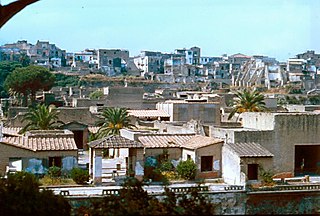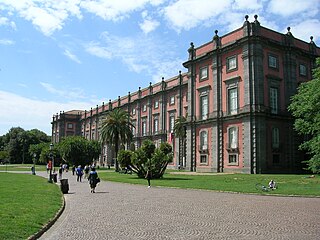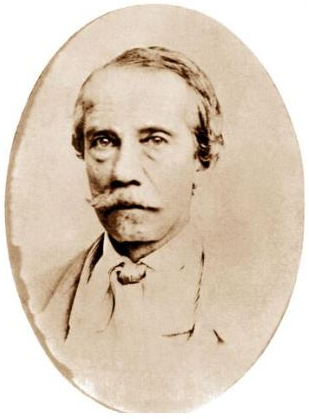
Sorrento is a town overlooking the Bay of Naples in Southern Italy. A popular tourist destination, Sorrento is located on the Sorrentine Peninsula at the south-eastern terminus of the Circumvesuviana rail line, within easy access from Naples and Pompei. The town is widely known for its small ceramics, lacework and marquetry (woodwork) shops.

Ca' Rezzonico is a palazzo and art museum on the Grand Canal in the Dorsoduro sestiere of Venice, Italy. It is a particularly notable example of the 18th century Venetian baroque and rococo architecture and interior decoration, and displays paintings by the leading Venetian painters of the period, including Francesco Guardi and Giambattista Tiepolo. It is a public museum dedicated to 18th-century Venice and one of the 11 venues managed by the Fondazione Musei Civici di Venezia.

The National Archaeological Museum of Naples is an important Italian archaeological museum, particularly for ancient Roman remains. Its collection includes works from Greek, Roman and Renaissance times, and especially Roman artifacts from the nearby Pompeii, Stabiae and Herculaneum sites. From 1816 to 1861, it was known as Real Museo Borbonico.

Museo di Capodimonte is an art museum located in the Palace of Capodimonte, a grand Bourbon palazzo in Naples, Italy designed by Giovanni Antonio Medrano. The museum is the prime repository of Neapolitan painting and decorative art, with several important works from other Italian schools of painting, and some important ancient Roman sculptures. It is one of the largest museums in Italy. The museum was inaugurated in 1957.

Ercolano is a town and comune in the Metropolitan City of Naples, Campania of Southern Italy. It lies at the western foot of Mount Vesuvius, on the Bay of Naples, just southeast of the city of Naples. The medieval town of Resina was built on the volcanic material left by the eruption of Vesuvius that destroyed the ancient city of Herculaneum, from which the present name is derived. Ercolano is a resort and the starting point for excursions to the excavations of Herculaneum and for the ascent of Vesuvius by bus. The town also manufactures leather goods, buttons, glass, and Lacryma Christi wine.

The National Roman Museum is a museum, with several branches in separate buildings throughout the city of Rome, Italy. It shows exhibits from the pre- and early history of Rome, with a focus on archaeological findings from the period of Ancient Rome.

The Museo Correr is a museum in Venice, northern Italy. Located in St. Mark's Square, Venice, it is one of the 11 civic museums run by the Fondazione Musei Civici di Venezia. The museum extends along the southside of the square on the upper floors of the Procuratorie Nuove. With its rich and varied collections, the Museo Correr covers both the art and history of Venice.

Museo Nazionale Scienza e Tecnologia Leonardo da Vinci in Milan, dedicated to painter and scientist Leonardo da Vinci, is the largest science and technology museum in Italy. It was opened on 15 February 1953 and inaugurated by Prime Minister Alcide De Gasperi.

Abate Andrea Belvedere was an Italian painter of the Baroque period.

The Stibbert Museum is located on via Frederick Stibbert on the hill of Montughi in Florence, Italy. The museum contains over 36,000 artifacts, including a vast collection of armour from Eastern and Western civilizations.

The Museo internazionale e biblioteca della musica is a music museum and music library in the Palazzo Aldini Sanguinetti, in the historic center of Bologna, Italy.

The Royal Palace of Capodimonte is a large palazzo in Naples, Italy. It was formerly the summer residence and hunting lodge of the Bourbon kings of the Two Sicilies, one of the two royal palaces in Naples. Today, the main building holds the main Neapolitan museum for paintings, and much other post-ancient art, in the National Museum of Capodimonte. This has the best collection of paintings from the distinct tradition of Neapolitan art, and also many works from the Farnese Collection.

Carlo Teodoro Duclère was an Italian landscape painter; associated with the School of Posillipo.

The Museo Storico Nazionale dell'Arte Sanitaria is located within the Ospedale di Santo Spirito in Sassia at 3, Lungotevere in Sassia in Rome (Italy).

The National Museum of Ceramics Duca Di Martina is a historical and artistic site situated inside of the Villa Floridiana Park in Naples, Italy. The building used to be one of Campania’s Bourbon royal residences and since 1927 this residence has hosted the museum.

The Villa Croce Museum of Contemporary Art is a permanent collection of Italian and international contemporary art hosted in a villa in the Carignano quarter of Genoa, northwestern Italy. The villa, donated to the city by the Croce family in 1951, is surrounded by public park with sea views, overhanging the Fiera di Genova exhibition center. It contains more than 3000 works of arts.

Aniello Ascione was an Italian painter of still lifes. He is regarded as an important representative of the Flemish style of Baroque still life painting and a follower of the Flemish painter Abraham Brueghel who worked in Naples in the final quarter of the 17th century.

Giuseppe Pascaletti was an Italian painter. He was born in Fiumefreddo Bruzio, in what is now Calabria. Pascaletti was active mostly in Rome and in the Cosentino. He became a portraitist for the Roman nobility, and today is considered one of Cosentino's most prominent painters of the 18th century.

The Museo Civico Giovanni Fattori is the civic contemporary art museum of Livorno, located in Villa Mimbelli on Via San Jacopo in Acquaviva 65, a few blocks west of the Terraza Mascagni of Livorno, region of Tuscany, Italy.

The Museum Giuseppe Gianetti is a ceramics museum located in Saronno, Italy. The Museum includes collections of different types of porcelain, majolica, and ceramics that belonged to the Italian industrialist Giuseppe Gianetti. These showcase more than 200 pieces of Meissen porcelain, which represents the Museum's most substantial collection. Other collections cover Oriental porcelain, Italian and European majolica, and porcelain. The original collections have been expanded to include the Aldo Marcenaro Collection and a collection of contemporary ceramics.




















